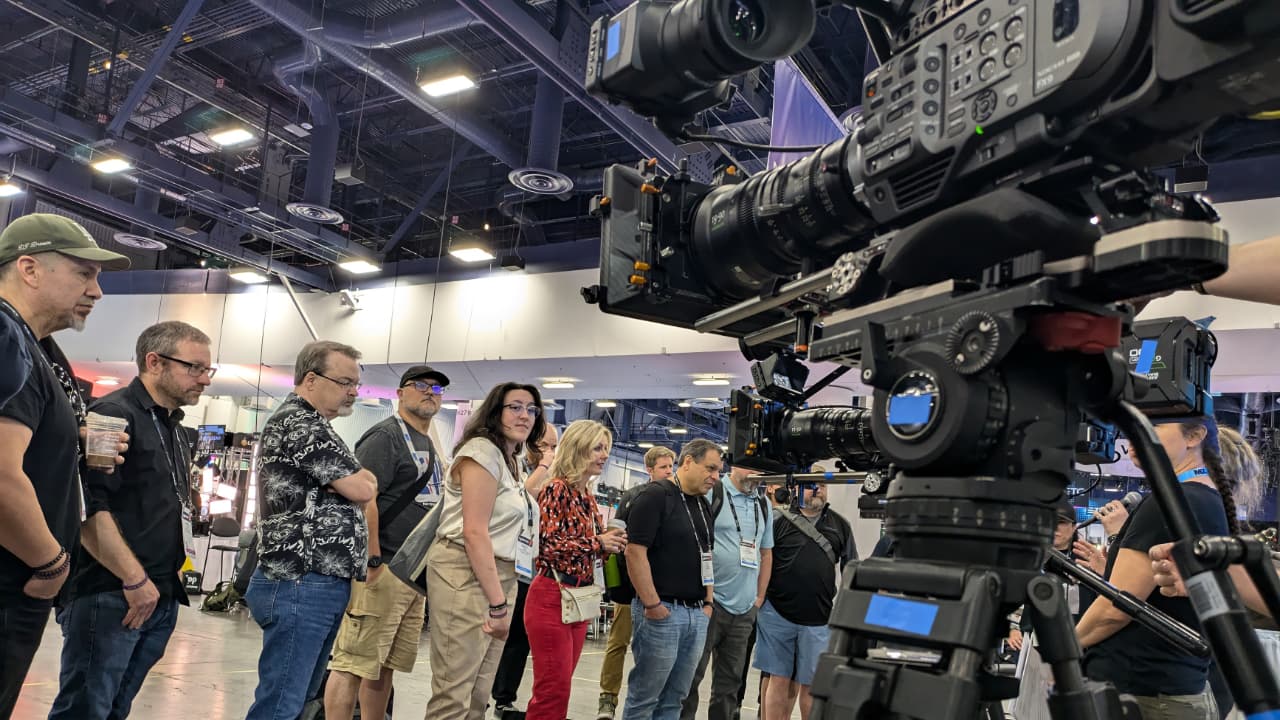
Phil Rhodes reports back from the CineCentral area at NAB where live demonstrations, expert-led training and immersive learning experiences can help shape future career paths.
There’s something which warms even the cryogenic core of your narrator’s flinty heart about the idea of recent graduates enjoying their first wobbly experiences operating a Scorpio crane. That became one of the more amusing moments of NAB 2024, alongside film loading workshops sponsored by Kodak and operating classes with experienced SOC members, among much else.
The CineCentral area moved with the camera and lighting exhibits from central to north halls this year to avoid the vast construction zone which currently forms the core of the Las Vegas Convention Centre. The show describes it as offering “live demonstrations, expert-led training and immersive learning experiences.” A cynic might posit that yes, of course Kodak wants people to know how to load film, and in the worst case there are as many magazine designs as there are cameras, and learning one of them won’t necessarily mean anyone is any better at loading another.
Still, everyone has to start somewhere, and in a situation where that start is either hard to arrange or tremendously expensive, the NAB offering - a comparatively modest $159 for students - seems like a very worthwhile way to spend a day or three. Training, after all, has never been more relevant for either Hollywood careerists or independents in a situation where expertise increasingly makes more difference than the zenith of technology, as has been the case for pushing a decade.
This year’s CineCentral programme included sessions on operating, assisting, loading, and even the application of cinema camera equipment in live production. With much of the world down on work, and some parts of the world alarmingly close to total unemployment, opportunities for focus pullers to go out on big broadcast jobs can only be a welcome relief, and there is every reason to integrate it into exactly this sort of training programme.
The end of specialisation?

It’s easy to reflect on the expectation that big trade shows have a theme of some sort which arises from the nature of the exhibits and the conversation which surrounds them. Whether or not it is ever realistic to sum up such a large, complex event in that way, the diversification of purpose is something which keeps coming up at NAB 2025. Movie-experienced camera assistants are being hired to work on broadcast jobs. IMAX is discussing its branded certification program for TV distribution. There was a time when cameras for lower-end productions had the displays and controls on the left, while those with grander ambitions had them on the right, for the camera assistant’s convenience.
Increasingly, cameras such as Blackmagic’s Ursa Cine and Fujifilm’s GFX Eterna, both heavily promoted at NAB this year, conspicuously offer both left- and right-sided controls. It is a tacit recognition, perhaps, that the modern world has become far less beholden to traditionally defined categories of work. People and products both need to act accordingly and it seems they both do.
If there’s a downside to this, it’s that there is inevitably less specialism in the world. The film industry has traditionally been intolerant of generalists, preferring people who do exactly one job well. Whether or not that’s a fair or reasonable expectation, it’s increasingly not representative of reality: cinema is no longer the only aspirational goal for young people; there’s online distribution, where the work is largely self-directed and can be a lot more creative than a multi-decade career spent mostly fetching boxes on a big movie. That comparison always raises eyebrows but given the mixed results of the very biggest big-screen entertainment, and the fact that we can easily find ourselves making a normal day rate to shoot 12K full frame anamorphic for Instagram
Well, let’s just be happy that the skill sets are so transferable.
The joy of filmmaking

Let’s be clear: nobody will step off the NABShow’s CineCentral area in a position to start as a crane grip, Steadicam operator or camera assistant the following day. Then again, nobody’s leaving a multi-year film course in that position either. Among the greybeards of the industry it’s easy, even fashionable, to grumble about new entrants. Let’s be clear, this has absolutely nothing to do with job protectionism, even though in the current market that sort of thinking has never been more understandable.
Still, the sheer joy on display is infectious. As to whether that enthusiasm is likely to be rewarded over a career spanning the next few decades, consider that economic woes come and go but filmmaking has spent a century showing us that, as a pastime and a career, it is probably pretty durable - at least for a sufficiently broad definition of “filmmaking.”
Tags: NAB 2025


Comments